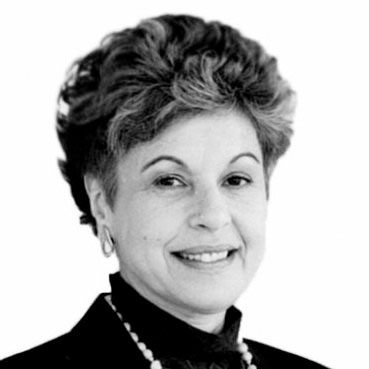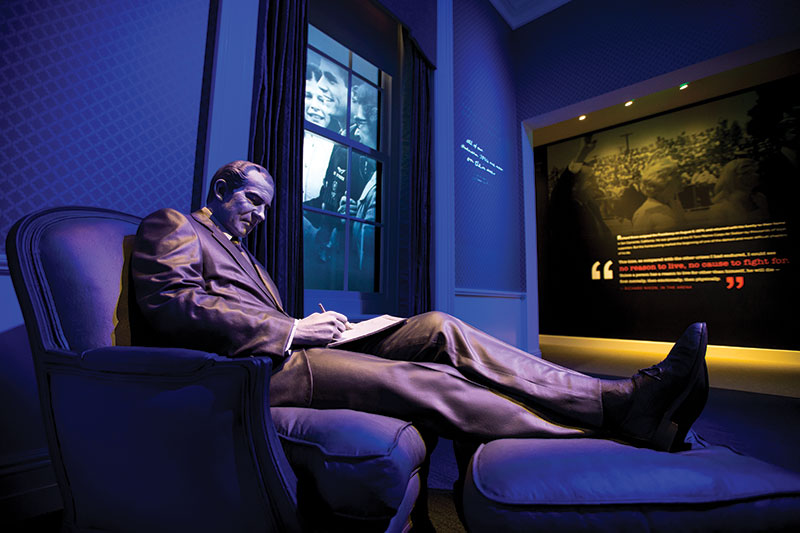By Vilma Barr
Creating a presidential library and museum can be compared to directing an independent film. A well-known actor is cast to attract an audience; a script graphically recounts a lifetime of far-reaching milestones; and handsome settings move the story along.
A complicated protagonist adds drama to the narrative. In the pantheon of U.S. presidents, arguably none is more complicated than Richard Nixon, and the museum that bears his name aims to tell his story and allow visitors to evaluate his legacy. Says designer Nick Davidson: “Through the use of hundreds of artifacts and interactive displays, guests can explore the President’s life and career from the inside so they can come to their own conclusions. Was he a peacemaker or warmonger? Did he leave the nation and the world a better place or not?”
To help answer these questions, an ambitious program to renovate and upgrade the content and visual image of the Richard Nixon Presidential Library and Museum in Yorba Linda, CA, was completed in the fall of 2016—the first such initiative since the facility opened in 1990.
A design team was organized under the auspices of the Richard Nixon Foundation and the National Archives Records Administration (NARA). Key members of the team included Los Angeles architect Langdon Wilson Architecture & Planning, the firm that designed the original facility, and creative consultancy Thinkwell Group, which earned a 2017 IES Illumination Award of Merit for the installation.
The design brief was succinct: replace the dated display and exhibits with a new, exciting and immersive guest experience. The mission was to rethink the original museum—opened when Nixon was still living—and craft exhibits that would stand up to the scrutiny of scholars, historians, the media and the public. Indeed, rather than proceeding chronologically, the experience “slams visitors right in the face,” by starting with Watergate, and then flashes back.
“Hundreds of additional artifacts were added to augment the collection,” says Davidson, senior lighting designer for Thinkwell Group. Davidson and his Thinkwell colleagues—Chuck Roberts, senior art director, and creative director Kate Mc- Donnell—were responsible for the dynamic new approach that the facility’s Board of Directors had set as its goal.
Authenticity was emphasized. Davidson describes how Thinkwell provided the White House curator with photos of the sconces and table lamps in the original design documentation, which they were charged with duplicating. Thinkwell indicated the information needed—dimensions, colors, finishes, etc. The curator, in turn, annotated these documents with historical background information. For instance, four of the original wall sconces were in storage, and the converted Argand desk lamps were actually in use in one of the White House offices. An artist was ultimately hired to duplicate the lamps based on the information from the curator. He used a variety of metal-bearing plastic casting compounds, polished the surfaces, then dulled and aged them using tinted waxes. Touches such as the tilted head of the Argand lamps and surface aging in the sconce carvings were then added. Lamps were electrified in their shop prior to being shipped to the Nixon Library. For positioning, Thinkwell scaled the dimensions from historical photography.
The 9-acre site includes both the museum and Nixon’s birthplace home, built by his father in 1912 a year before Nixon’s birth. Three linked pavilions form the main freestanding building. A rectangular reflecting pool terminates at the entrance to the residence.
CAREER AS EXHIBIT
Nixon’s political career got its start in 1946 when his California district elected him to the U.S. House of Representatives. He also served as a senator and vice president before being elected president in 1968. To visually relate the story of his term from 1969 to 1974, new galleries were constructed that combine architecture, display and lighting to inform and entertain visitors.
The complete exhibits were fabricated inhouse at Thinkwell. “As new ideas were approved by the Foundation, Chuck, Kate and I would discuss mood, tone and lighting dynamics. Each exhibit room was treated as its own environment, and then we linked them to flow from one to the other,” Davidson explains.
Davidson’s research for the project took different forms. “Because this exhibit combines both real and artificial artifacts, I became familiar with National Archives’ lighting requirements for artifacts to comply with California Title 24. Occupancy sensors were installed in each gallery zone, per NARA requirements,” he says. Each artifact case is fitted with locally dimmed fiber-optic lighting, controlled by a local proximity sensor.
Historical research was carried out for numerous theatrical moments within the exhibit. In the “Domestic Policy Vision” gallery, the re-creation of the first moon landing display presents two mannequins wearing moon garb; one is a real moon suit actually worn by an astronaut, and the second is a reproduction. The display is inverted above the entry to give a different perspective to the scene. “We studied imagery and then mocked up the lighting conditions at the Thinkwell office to tune the exact color on our three-dimensional representation. Ultimately, we used four fixtures [ETC Source Four LED Lustr profile] mounted out of visitors’ view. We focused them to replicate both color and shadow that we imagine would be found on the moon,” Davidson says.
A replica of the 800-sq ft Oval Office also rings true. LED luminaires from Philips Color Kinetics were used to simulate daylight coming through the large windows behind the desk. Cove lighting was tuned to the exact color temperature (3000K) used in the Oval Office at that time. Custom-fabricated wall sconces use warm 2700K incandescent lamps. This effect was combined with 3000K LED track lighting.
A figure of President Nixon in a recliner in the Lincoln Sitting Room is also shown. This was a favorite area where he would spend time alone to study reports or draft memos and other correspondence. Visitors can stand in the middle of the room to experience the ambience created by the lighting, audio, mapped projection and media behind the windows. The lighting fixtures for the effects are ETC Source Four Mini LED, beamed for sharp focus on Nixon. ETC D20 Lustr fixtures provide theatrical wall washing.
For the dramatic “The Week that Changed the World” display, a photomural with Air Force One in the background depicts President Nixon and Chinese Premier Zhou Enlai during Nixon’s 1972 trip to the People’s Republic of China. In-case fiber-optic artifact lighting is complemented by 3000K LED track lighting. Panels are offset with 3500K backlighting.
The designers gave implied animation to “The Vietnam War” display. Figures of three U.S. Army officers appear to have just jumped out of the illuminated panel of the helicopter behind them. Warm 2700K LED track lighting was used in conjunction with LED theatrical fixtures fitted with custom gobo templates. ETC Source Four Mini LEDs were fitted with a custom gobo template
and custom color filter to match the graphic.
“Although this project was filled with integration challenges, we were very fortunate to have all technical design done in tandem with the exhibit design,” says Davidson. “My background is theatrical lighting design, so I was able to apply many of those techniques to a modern-day immersive museum exhibition. I really wanted to push the boundaries of using color, texture and angle of light in a way that really enhances the storytelling in each room and gallery.”


